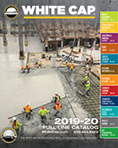ACI Updates Concrete Repair Code
What’s New in the ACI 562-19 Repair code?
Scope
Repair professionals now have a better path towards success with the publication of the recently updated ACI Code Requirements for Evaluation, Repair, and Rehabilitation of Concrete Structures and Commentary (ACI562-19). The new document includes a wide range of updates that improve the integration with both the ACI 318 Building Code Requirements for Structural Concrete and the ICC International Existing Building Code. There are some specific updates that may affect contractors as they prepare proposals for repairs.
Four key updates from ACI 562-16 to ACI 562-19 include:
Specific Outline Of Required Documentation
- The requirements for the basis of design report were simplified in Chapter 1. The Code now outlines what the project’s licensed design professional must document for the basis of design. Some of the items they must address include: work categories and repair construction within the work area for each structural element, including the building’s description, any modifications since original construction, potential shoring requirements, QA/QC, and repair materials.
Easier To Add/Approve New Materials
- The new code makes it easier for licensed design professionals to include new materials in their basis of design. New repair materials can be approved by the authority having jurisdiction through alternative means and methods, as stated in the building design-basis code. Additionally, repair materials that are evaluated in a process equivalent to the requirements of the IBC can also be used.
Clarified Requirements On Reinforced Steel (Chapter 4)
- The requirements related to detailing of existing reinforcing steel in Chapter 4 have been clarified. Designers should use the current building code to detail new concrete members and the connections between new concrete members and existing construction. But when the original building code is used as the design-basis criteria for repairs, the original building code shall also be used for design. The new wording also provides guidance on how to incorporate new elements into the old construction design.
Listing Of Exposure Categories That May Affect Durability
- The commentary in Chapter 8 was updated to include a listing of exposure categories that may affect durability. These exposure categories help identify the type of repair and materials that should be considered. For instance, the categories describe levels of freeze-thaw and water intrusion exposures.
Facts about the Concrete Repair Code
The American Concrete Institute first published the Code Requirements for Evaluation, Repair, and Rehabilitation of Concrete Buildings in 2013. It was the first code specifically for repairing reinforced concrete. These type of structures typically include: parking garages, façade repairs; conversion of historic structure for new uses, and strengthening of concrete floors and walls for either additional loading or seismic upgrade.
Local jurisdictions have the opportunity to adopt the codes for their communities. This repair code was developed so that a building owner could adopt its requirements as part of the overall project specification.
Commentary
Traditionally engineers and contractors approached the production and repair of concrete structures on a case-by-case basis. While there were many supporting documents, there had been no consensus document for building code officials to refer to in the approval process. In 2013, ACI published its first version the ACI 562 code. It was specifically written to be integrated into building codes as a mechanism for building officials to have increased confidence that repairs are performed in a manner that provides an acceptable level of protection for the public.
The code is a versatile roadmap to the proper and durable structural repair of a building.
According to ACI, the repair code provides:
- Owners with confidence that their repair projects will be designed to a common standard,
- Engineers with a uniform set of requirements specific to existing concrete structures,
- Building Officials with a basis upon which to evaluate design and construction, and
- Contractors with clarification of responsibilities.
There’s been a great deal of research supporting the information contained in the code.
Contractors and engineers have access to this data through several main industry sources.
 1. ACI recently launched a new Concrete Repair Online Subscription which includes digital access to the American Concrete Institute’s technical and education content on concrete assessment, repair, and rehabilitation. This includes access to ACI’s existing concrete repair-specific code requirements/commentary, specifications, and guides.
1. ACI recently launched a new Concrete Repair Online Subscription which includes digital access to the American Concrete Institute’s technical and education content on concrete assessment, repair, and rehabilitation. This includes access to ACI’s existing concrete repair-specific code requirements/commentary, specifications, and guides.
 2. Last year, ACI also released the first ever concrete repair specifications. ACI 563-18 Specifications for Repair of Concrete in Buildings is a reference specification that the design professional can apply to any construction repair and rehabilitation project involving structural concrete by citing it in the project specifications.
2. Last year, ACI also released the first ever concrete repair specifications. ACI 563-18 Specifications for Repair of Concrete in Buildings is a reference specification that the design professional can apply to any construction repair and rehabilitation project involving structural concrete by citing it in the project specifications.
 3. The American Concrete Institute and the International Concrete Repair Institute (ICRI) have published the Guide to the Code for Evaluation, Repair, and Rehabilitation of Concrete Buildings, a resource that makes the code easier to understand and implement. The companion guide helps designers and contractors interpret the requirements of ACI 562 and apply them to specific situations.
3. The American Concrete Institute and the International Concrete Repair Institute (ICRI) have published the Guide to the Code for Evaluation, Repair, and Rehabilitation of Concrete Buildings, a resource that makes the code easier to understand and implement. The companion guide helps designers and contractors interpret the requirements of ACI 562 and apply them to specific situations.
In related news, the Ohio Building Code has approved ACI 562 Code Requirements for Assessment, Repair, and Rehabilitation of Existing Concrete Structures and Commentary to be used in repair projects. Atlanta and several other cities/states are also considering the requirement.
ICRI has published a wide range of technical documents on the repair of concrete. These documents can be reviewed at www.icri.org.
![]()
For more info on Concrete Repair and related issues:
https://www.concrete.org/portals/0/files/pdf/webinars/ws_F18_Kesner.pdf



